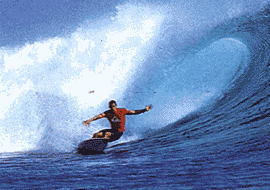Surfing
Sidewalk surfing has a similar feel to surfing and requires only a paved road or sidewalk. George Freeth decided to revive the art of surfing, but had little success with the huge 16-foot hardwood boards that were popular at that time. While on vacation, Huntington had seen Hawaiian boys surfing the island waves. Body surfing, where the wave is surfed without a board, using the surfer's own body to catch and ride the wave, is very common and is considered by some to be the purest form of surfing.
Snapper Rocks is a sand bottom point break considered as a world renowned surfing spot on the Gold Coast. To create the feel of the wave, surfers even sneak into empty backyard swimming pools to ride in, known as pool skating. Looking for a way to entice visitors to the area of Redondo Beach, where he had heavily invested in real estate, he hired a young Hawaiian to ride surfboards. The native peoples of the Pacific, for instance, surfed waves on alaia, paipo, and other such craft, and did so on their belly and knees. Many other board sports have been invented over the years, but all can trace their heritage back to surfing.
One variety of stand-up surfing is paddle boarding. However, waves can be found wherever there is coastline, and a tight-knit yet far-reaching subculture of surfers has emerged throughout America. When he cut them in half to make them more manageable, he created the original "Long board", which made him the talk of the islands. When the waves were flat, surfers persevered with sidewalk surfing, which is now called skateboarding. Other types of surfing include knee boarding, surf matting (riding inflatable mats), and using foils. Some historical markers of the culture included the woodie, the station wagon used to carry surfers' boards, as well as boardshorts, the long swim shorts typically worn while surfing. It is also a favourite surfing spot of local world champs, Mick Fanning, Joel Parkinson and Stephanie Gilmore, who enjoy nothing more than surfing their own 'local' break when they're at home.
Surfers represent a diverse culture based on riding the waves. The modern-day definition of surfing, however, most often refers to a surfer riding a wave standing up on a surfboard; this is also referred to as stand-up surfing.
In 1907, the eclectic interests of the land baron Henry Huntington brought the ancient art of surfing to the California coast. The swell here often reaches six to eight feet, and one good, clean wave can transport you from Snapper to Kirra, a distance of almost two kilometres. Another prominent form of surfing is body boarding, when a surfer rides a wave on a bodyboard, either lying on their belly, drop knee, or sometimes even standing up on a body board. Eventually, surfing made its way to the slopes with the invention of the Snurfer, later credited as the first snowboard. To the delight of visitors, Freeth exhibited his surfing skills twice a day in front of the Hotel Redondo. Snapper, located at Rainbow Bay, is home to the world-famous 'Super Bank', regarded in surfing circles as the longest, most consistent and most hollow wave in the world. Within the United States, surfing culture is most dominant in Hawaii and California because these two states offer the best surfing conditions. Some people practice surfing as a recreational activity while others make it the central focus of their lives. Snapper Rocks hosts elite international surfing events such as the Quiksilver and Roxy Pro, Rip Curl Masters, and MP Classic. Surfers also wear wetsuits in colder regions.
The term surfing refers to the act of riding a wave, regardless of whether the wave is ridden with a board or without a board, and regardless of the stance used (goofy or regular stance).
Bibliography
Surfing . (1970). Retrieved on June 9, 2015, from http://en.wikipedia.org/wiki/Surfing.
Article genereated by http://www.articlegeneratorpro.com, visit our website for more content generator software.
0 comments:
Post a Comment
Note: Only a member of this blog may post a comment.